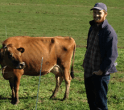 Consider the Density and Vigor of Your Cover Crop
Consider the Density and Vigor of Your Cover Crop
By Nate Severy
UVM Ext. Agronomy Outreach Professional
Over the past year there has been growing interest in the farming  community in trying to no-till alfalfa hay seedings into winter cover crops as a way of reducing erosion and saving time and fuel. Come spring, there will be a number of farmers who want to plant then or early summer who will look at their fields wondering “should I plant now, or wait until later?” While we have not yet done any formal research looking at alfalfa establishment under different management systems and the associated economics, there are some clues that may be able to guide us until we have more data.
community in trying to no-till alfalfa hay seedings into winter cover crops as a way of reducing erosion and saving time and fuel. Come spring, there will be a number of farmers who want to plant then or early summer who will look at their fields wondering “should I plant now, or wait until later?” While we have not yet done any formal research looking at alfalfa establishment under different management systems and the associated economics, there are some clues that may be able to guide us until we have more data.
One clue we can look at when deciding whether to plant in early spring or early summer is cover crop stand density. (Late-summer seeding is also a consideration that we won’t discuss in this article.) We know from helping farmers no-till-renovate pastures/hay fields that a productive and competitive hay field will outcompete your no-till seedlings for light and nutrients. We should expect this same thing to happen when we have cover crops.
A field was planted to winter rye after corn silage harvest in early September; by December it completely covered the soil surface and was between 4 and 6 inches high.

This success was due in part to early planting, full seeding rate, and timely rain. In spring, we expect that this crop is going to take-off and, with proper management, will be very high yielding. If alfalfa mix were planted into this stand in April without any control methods, will our seedlings be able to compete? Maybe, but we wouldn’t count on it. We are not suggesting that a productive stand is bad, as it provides many environmental and economics benefits, but it must be managed correctly. So, in this situation, we would recommend that before seeding an alfalfa mix, a farmer should either terminate the cover crop, or wait until mid-May and harvest for livestock feed before seeding. If the field is terminated in April, the alfalfa should be planted with a nurse crop like barley or oats. If properly killed, the winter rye will be barely noticeable after about a month. If there is no nurse crop, there will be a substantial amount of bare ground which will be susceptible to erosion and weed pressure.
Another field was planted in late September 2015 to winter rye after corn silage harvest. By early April 2016, although the cover crop did protect against erosion, there was still a lot of bare soil.

A crop like this can produce high quality livestock feed, but will be very low yielding. In this type of situation, the farmer can go ahead and plant alfalfa mix. S/he can terminate the cover crop beforehand, but there should be enough open canopy that the cover crop should not be a problem. This winter rye can later be mowed for livestock feed, or possibly even left and combined for seed for next fall’s cover crop.
Do you have questions about this work or would like assistance with no-till alfalfa? Contact Nate [802-388-4969 ext. 348, nathaniel.severy@uvm.edu]
